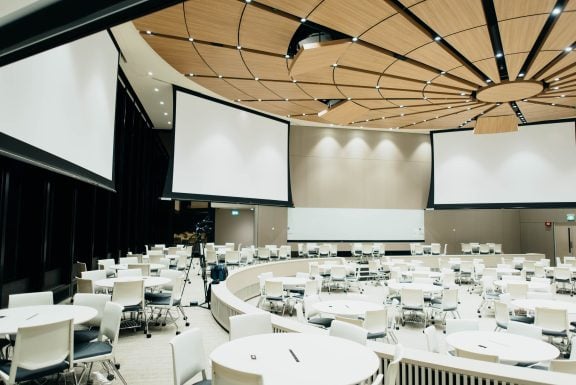Only 7% of Your Communication is Verbal, Are You Wasting the Other 93%?
This commonly-cited statistic is based on a famous study by Mehrabian and Ferris, first published in 1967 and has been confirmed by other studies since then. Of course, the findings have been challenged and Mehrabian himself acknowledged that they are more accurate in certain situations than in others.
Before you decide to throw out any emphasis on tonality, body language, or facial expression in your presentations it is worth considering a few facts because there is a reason why Neuro-Linguistic Programming (NLP) emphasizes the importance of awareness of non-verbal communication patterns as well as verbal ones.
3 Reasons Why Live Events and Video Convert Better Than Any Other Medium
There is a reason why so many people hold live events (including conferences, meetings, seminars, and sales presentations) these days and it is economic, not sentimental. It certainly isn’t a question of convenience because live events are complex and expensive to host. Video is the closest remote alternative and shares many (but not all) of the positive characteristics of a live event.
- Increasing Investment. It is well-known and tested that the longer you engage with a person (reading, listening, watching, conversing), the more you are invested in their idea and personality and the more likely you are to buy from or promote them.
- Building Trust. Observing a person’s facial expressions and body language and listening to their voice builds trust assuming that these are congruent with the message they deliver.
- Enhancing Connection. We buy from people we know, like, and trust, and actually watching and listening to a person enhances rapport and a sense of connection.
This is why organizing a live event can be incredibly powerful and why the sales results that they deliver make the effort and expense worthwhile. The simple fact that your audience has expended a great deal of effort to turn up in person makes them more open and receptive to your message.
Are Your Non-Verbal Cues Contradicting Your Message
Most people’s non-verbal communication is unconscious. In everyday conversations, you have probably noticed people whose words say one thing, which their body language and tonality flatly contradicts. Sales people who are trying to sell a product, and friends or family members who want to be ˜nice’ are the most common offenders. They may say, “I know that this product will fit your need, and this is the best price I can offer you.” Or “That dress looks fantastic.” Yet, at the same time, you notice from their unwillingness to maintain eye contact, the way they lean away from you in their chair, or some other subtle movements that demonstrate they are not as truly convinced as they hope you will believe. This portion of any Neuro-Linguistic Programming (NLP) course frequently creates the greatest transformation in students’ relationships, both personal and business.
Speakers often do the same thing. They have carefully prepared the words they are going to speak in order to convey a particular message. They, or possibly their speechwriter, have determined the language patterns they should use, the precise terminology and phraseology which will move the audience most certainly towards their desired outcome, and the vocal inflections that will most surely convey their message. However, it is often clear through their gestures and body language that they themselves are not totally congruent with their message.
Are Your Non-Verbal Cues Distracting from Your Message
A speaker may be 100% sincere with absolute congruence between their body language and their words, but, their unconscious gestures might distract the audience and prevent their message sinking in. I have listened to presentations where I have been compelled to shut my eyes so that I cannot see the presenter in order to focus on what he or she is saying. This is not good when your presentation is designed to create a specific outcome!
When you become aware of your unconscious gestures you are in a position to choose those gestures and expressions which will serve your goals and eliminate those which distract from them. Some gestures are appropriate in certain settings, and inappropriate in other settings. Do you know what gestures they might be? Have you ever thought about the message that your eye contact (or lack thereof), your hand gestures, your pacing, or your stance might communicate?
Using Non-Verbal Cues to Reinforce Your Message
When you are in full view of an audience (live or via video) you can amplify the desired result by ensuring that your movements, gestures, facial expressions, voice tonality, and eye contact are congruent with every word you speak.
Even if you are sitting behind your screen and your audience only hears your voice, unless you focus on your words as you speak, the goals you have for your presentation, and the complete picture that you want to present it will come through to your audience. It is important to act as though you are in full view of the audience and they can see every gesture you make so that your words carry the full conviction of your thoughts. It is amazing what a difference this makes to your outcome.
You may have seen speakers who pace incessantly during their speeches and move around while they are speaking. This is not wrong. It can be a great way of engaging your audience and anchoring their emotions and their thoughts to certain concepts or parts of the stage. The important thing to learn is how to do this consciously rather than simply have it occur by default.
Anchoring is a powerful Neuro-Linguistic Programming (NLP) concept that speakers can use to reinforce their message. However, speakers who don’t understand this concept can confuse their audience by simply using the same spot on stage to anchor contradictory messages and emotions. Many comedians can evoke laughter from the audience simply by gesturing toward the position from which they previously told a joke. Politicians use similar tactics to evoke outrage or anger from constituents. As a speaker, this is a very powerful tool for attracting, holding, and reigniting your audience’s interest and leading them towards your desired outcome.
Sign up for NLP Practitioner, Master Practitioner, Trainers’ Training




